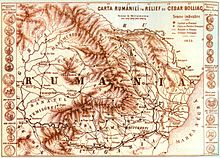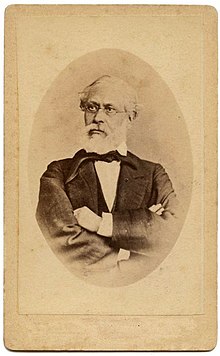|
Cezar Bolliac
 Cezar Bolliac or Boliac, Boliak (23 March 1813 – 25 February 1881) was a Wallachian and Romanian radical political figure, amateur archaeologist, journalist and Romantic poet. LifeEarly lifeBorn in Bucharest as the son of Anton Bogliako (Bogliacco or Bolliac), a Greek-Italian physician, and his wife Zinca Pereț, who remarried the stolnic Petrache Pereț; his adoptive father took care of Cezar's education. After being taught reading and writing at home, Bolliac studied at the Saint Sava Academy, under Ion Heliade Rădulescu; Rădulescu was to become one of his most important collaborators. In 1830, he joined the newly refounded Wallachian Army as a member of its officer corps. Three years later, Bolliac became a member of the secret Philharmonic Society, created by Ion Câmpineanu, Rădulescu, and Constantin Aristia. In 1835, he published his first lyrical works. A year later, he began editing the review Curiosul. Frăția and manifestosWith fellow radicals Nicolae Bălcescu and Eftimie Murgu, Bolliac joined in Mitică Filipescu's conspiracy against Prince Alexandru II Ghica and, later in the year, entered the Freemasonry-inspired Frăția ("Brotherhood") secret society. In 1844, through the means of Foaie pentru minte, inimă și literatură, he appealed to young writers:
In an article he published in 1846 in the pages of the same magazine, Bolliac showed his admiration for the works and attitudes of Victor Hugo, which he recommended as a guide to Wallachian writers. Revolution and later lifeConsequently, he was one of the leaders of the 1848 Wallachian revolution, and took exile after the Ottoman–Russian intervention in September. In Brașov, Transylvania (on Austrian domain), Bolliac began publishing Espatriatul, a paper which featured the subtitle Dreptate, Frăție ("Justice, Brotherhood"), a rendition of the revolutionary slogan. After 1857, he settled in Paris, and published the French-language poem Domnul Tudor. Episode de la révolution roumaine de 1821 ("Voivode Tudor. An Episode of the 1821 Wallachian uprising|1821 Romanian Revolution"), and began issuing his review Buciumul, a mainly political magazine. He returned to Wallachia in 1858, after the Crimean War had led to a drastic decrease in Russian influence (allowing for radicals to regin their country), and took an archaeological study trip. He included the results of his investigations in Buciumul and its successor Trompeta Carpaților (he began editing the latter in 1865). During the period, Bolliac also engaged in activism in favor of Wallachia's union with Moldavia, a goal reached under Alexandru Ioan Cuza. He later became a notorious antisemite, rejected the idea of naturalization for the Jews, and engaged in a polemic over this issue (and that of his version of Romanticism in general) with Junimea's Titu Maiorescu.[1] His wife, Aristița (née Isvoranu) died in 1860, and was buried at Bellu Cemetery (Bolliac was the second person to buy a plot there, after C. A. Rosetti).[2][3] He died in 1881 in Bucharest, by then the capital of the Kingdom of Romania. Published volumes
Notes
References
|
||||||||||||||||
Portal di Ensiklopedia Dunia
